
TWIN PALMS (1947–1957)
1148 East Alejo Road, Palm Springs
In 1947, Frank Sinatra had become a millionaire, and so he followed the lead of many other show business millionaires — he headed to Palm Springs.
He’d been going there for years, taking advantage of the desert’s relaxing atmosphere at the Lone Palm Hotel, according to his daughter Nancy, but he was getting ready to settle in now that he had the dough. The choice of asylums was easy: For decades, Palm Springs had served as a sleep-away camp for celebrities, a place where everyone stopped asking questions as soon as you crossed Windy Point.
Frank made up his mind. He would build a little home, just meant for two, a place he could get away from it all. And he’d build it in Loveland Palm Springs.
On second thought, he’d build it a little bit further away, actually. Back then most of the action was at Charlie Farrell and Ralph Bellamy’s Racquet Club on the north side of the village, but Frank did not like it there much.
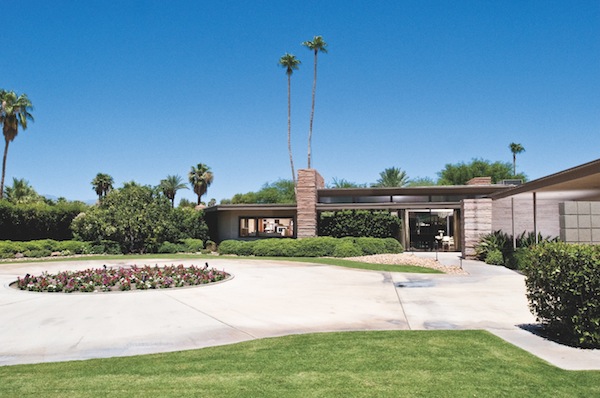
PHOTOGRAPH COURTESY OF BEAU MONDE VILLAS
Designed by E. Stewart Williams in 1947 for Sinatra and his first wife, Nancy Barbato, Twin Palms is a stunning example of midcentury architecture.
Sinatra wanted his own house with his own friends around. In May, he walked into the architecture offices of Williams, Williams and Williams and talked to one of the Williamses, E. Stewart. He asked a few questions and then dropped the bomb. The house would have to be designed and built in time for holiday entertaining a mere seven months away.
And it was a good thing Sinatra was now a millionaire: “We used triple shifts,” the late Williams recalled, sending the costs skyward.
Sinatra envisioned a sort of Georgian-type mansion, but E. Stewart had other ideas: a perfectly Palm Springs midcentury home, in a style currently in mad vogue all over the desert. Glass, steel, and simplicity. And by Christmas it was ready, nicknamed “Twin Palms” for the two impossibly tall trunks on the property.
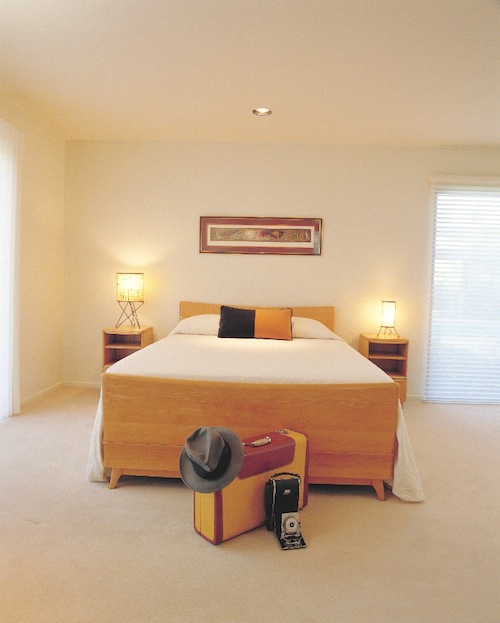
PHOTOGRAPH BY ARTHUR COLEMAN
One of the Twin Palms bedrooms. The property is now a luxury vacation rental.
It was there at Twin Palms that Sinatra could escape from the hounding press as well as the feeling that somehow Hollywood had not fully accepted him. And it was Twin Palms that would bear witness to the great drama that was his infatuation, second marriage, and chain of heartbreak with Ava Gardner.
“The [Twin Palms] house was the site of the most spectacular fight of our young married life,” Ava once revealed. “We were always having one of our fights — as if that was anything new. I was always deciding that I couldn’t live with him, and he was always trying to bring me back.”
Furniture and fixtures, by the way, often took a beating at Twin Palms. One of the sinks in the master bedroom, for example, got whacked by a hurled Champagne bottle, the damage still visible today.
The Frank–Ava marriage lasted six years but ended in exhaustion and divorce in 1957. Sinatra, not about to live with those memories but still wanting to live in the desert, sold the home and moved east to what was then called Wonder Palms Road and Tamarisk Country Club
WONDER PALMS COMPOUND (1957–1998)
70588 Frank Sinatra Drive, Rancho Mirage
Frank may have moved out of Palm Springs, but he took a little of Palm Springs with him when he moved east into the unincorporated area now known as Rancho Mirage. His choice of architecture style? Not midcentury — at least not mid-20th-century. The idea for the new digs was more mid-19th-century à la Smoke Tree Ranch in Palm Springs.
Frank bought a little house on the 17th fairway at Tamarisk Country Club, which would become “the” Sinatra house of the desert, his home until he died four decades later.
Ranch décor was the motif.
Architectural Digest described the original house as “one-story … [with a] rough stone entrance and vertical sand-colored clapboard siding.” And Sinatra’s home wasn’t very private at first, set as it was right on the fairway. In Nancy Sinatra’s book, Frank Sinatra, My Father, she remembered that sometimes “golfers [off the fairway abutting the property] actually walked into the house. One clown drove a golf cart into the pool.”
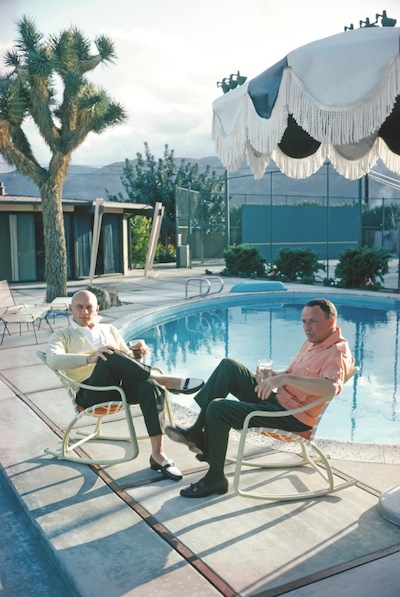
PHOTOGRAPH BY JOHN BRYSON/SYGMA/CORBIS
The King and The Chairman: Yul Brynner and Frank Sinatra poolside at Wonder Palms Compound in Rancho Mirage.
But as Sinatra’s career grew, so did the property and his need for privacy. AD reported that Frank “added a pair of two-bedroom cottages, one off either end of the pool. Each bedroom had its own separate bath, hers equipped with Helene Curtis professional salon hair dryers.” The magazine also gushed over the main house additions, including a dining room for 24 and a walk-in refrigerator and freezer.
Wonder Palms was also the site of Sinatra and his third wife Mia Farrow’s first getaway. Brad Dexter (who had once saved Sinatra’s life — and, later, when in a spat with Ol’ Blue Eyes, said he regretted it) remembered that Mia had come to see Frank on the set of Von Ryan’s Express, a movie Dexter was coproducing. As they were leaving the set, Frank mentioned he was going to Palm Springs and asked Mia to come along.
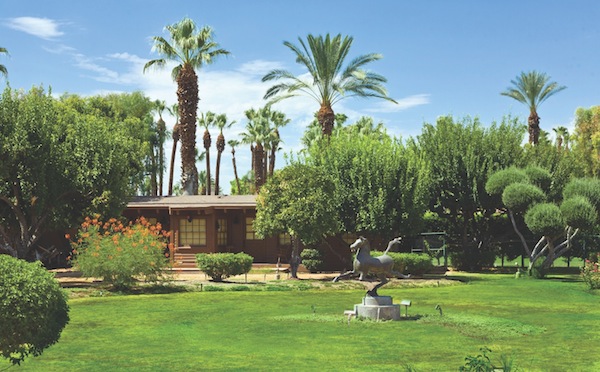
PHOTOGRAPH COURTESY PALMS SPRINGS LIFE ARCHIVES
Frank Sinatra added significantly to the property, located on the 17th fairway at Tamarisk Country Club, to increase his privacy.
Frank couldn’t believe she said yes. As soon as they settled into the weekend together on the estate, Frank’s female friends knew it was going to end up at the altar.The marriage to Mia lasted just a few years, aborted abruptly by a visit from Sinatra’s lawyer arriving on the set of Rosemary’s Baby, divorce papers in hand. It was an odd mix with Mia anyway, a hippie chick trusting someone waaaaaay over 30. How she fit into the parties at the Compound, whose guest lists included Auntie Mame Rosalind Russell, Random House’s Bennett Cerf and West Coast intellectuals like Harold and Maude’s Ruth Gordon and writer-director Garson Kanin (Born Yesterday) is anybody’s guess. One guest remembered that she often stared into space while petting a large white cat.
After Mia, the Compound saw more than its fair share of affairs between Sinatra and beautiful women. But none seemed to get beyond the one-night-stand category until Barbara Blakeley Marx entered Frank’s life. A neighbor at Tamarisk Country Club, she and Frank had met at many social events and eventually married on the grounds of the estate in 1976.
Over the years, the original two-bedroom “cottage” exploded, eventually comprising nine guest bedrooms, two pools, a tennis court, and a helipad. And there were unique buildings, too, one the children called, “The Christmas Tree House” and also “The Caboose.”
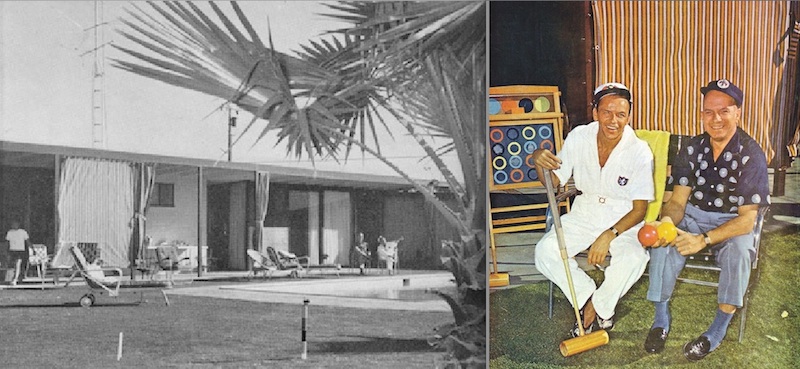
PHOTOGRAPH COURTESY PALMS SPRINGS LIFE ARCHIVES
Relaxing after a heated croquet contest with Rancho Mirage pal and songwriter Jimmy Van Heusen.
The Christmas Tree House was a separate four-bedroom dwelling with a big living room–kitchen area, so named because of the big pine trees in front, so out of place. It looked like nothing else on the property — white with dark green shutters topped with a shingled roof straight out of the Northeast.
The Caboose, and a small house adjacent that included a sauna, a massage table, a barber chair, an exercise bench, and Toledo scale, housed Sinatra’s favorite hobby: electric trains. It was Sinatra’s most consuming hobby. On most days, The Caboose was a funhouse where at least six electric trains at a time clicketedand clacketed, whistled and blew off steam, riding past small towns, big cities, over bridges, past depots, crossing alien vistas, and mesmerizing anyone lucky enough to be allowed in.
Frank would don a bright engineer’s hat and would blow a solid gold train whistle set with diamonds and rubies.
All together there were 200 trains, aping the famed Lionel showroom in New York, alongside miniature mountains, factories, houses and bridges — and a little replica of Sinatra’s hometown, Hoboken. Barbara remembered there was also an old western town, a billboard announcing a sold-out Sinatra concert, and an old-fashioned New Orleans riverboat. Hanging from the ceiling were replicas of all the planes he’d ever owned. A plaque on the wall said it all about The Caboose: He Who Dies With the Most Toys Wins.
Trains weren’t the only unique décor elements at the Compound. There was also orange. A lot of orange. It was Frank’s favorite color. Period.

PHOTOGRAPH COURTESY REX USA
Frank Sinatra keeping cool in the Compound’s pool. His expression reflects his well-known disdain for journalists of the day.
In the Wonder Palms Compound, there was orange carpeting. There was orange tile. In the kitchen, the refrigerator was orange, and other rooms opened to reveal an orange sofa, orange drapes, and orange towels at the ready. Sweaters piled high in his dressing area were orange. “It’s the happiest color,” he said.
The origin of Frank’s infatuation with the color is lost to history, but it is often associated with a need for attention (which is why traffic cones and emergency vests are orange).
After Frank married Barbara in 1976, orange became a subject of a décor discussion. The 10 years during which Frank had entertained at the property before the marriage had taken their toll; the place had turned shabby without the chic. Since Barbara, a former modeling school owner, fashion model, and the picture of poise and elegance, was chic, one can see how there might be some colloquy on refreshing and redecorating and, specifically, all that freaking orange.
But if Frank thought he could bulldoze Barbara into living inside a safety cone, he underestimated her steely spine. Eventually a lot of the orange turned desert coral and white.
Still, if Frank wanted a hit of orange he had one more place to go. He owned a mountain retreat in the mountains above Palm Desert, Villa Maggio, where orange ruled and Barbara evidently didn’t mind.
VILLA MAGGIO (1971–1983)
70300 San Lorenzo Road, Mountain Center
By the early 1970s, America’s busiest bachelor was ready to hang it up. Frank thought maybe it was time to retire, retreat. He wanted to really get away. But where? He still wanted to stay in the desert.
Son Frank Jr. had spent part of his teenage years at the Desert Sun School at the Idyllwild Arts Academy in the mountains above Palm Desert, and on his many trips back and forth, south along serpentine State Highway 74, Frank had noticed a small community of houses about two-thirds of the way up one of the Santa Rosa Mountains. It didn’t get any more out of the way than that. It was up there, 4,500 feet above the Salton Sea level, that he built Villa Maggio, his retirement palace.
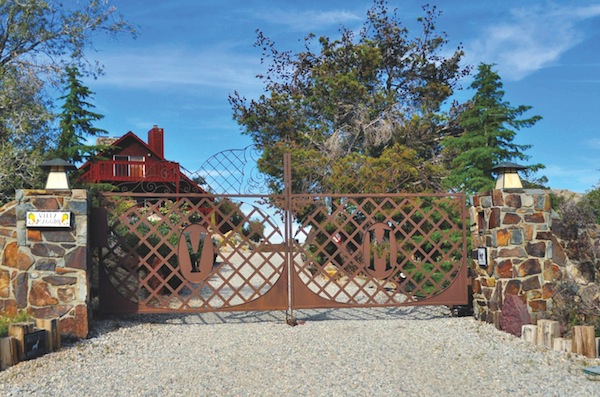
PHOTOGRAPHS BY ANTHONY LAGROSA AND ABRAHAM RIVERA
Villa Maggio was named after the character Sinatra played in From Here to Eternity, the role that earned him an Academy Award.
At seven and a half acres, there was plenty of room for his architect, Ross Patton, to create the perfect hideaway and playpen for Frank and his Rat Pack, beginning in 1967. The first thing he built on this plateau of the granite mountain was a private, gated road. Then the complex took shape. There were three buildings in all: a five-bedroom main house, a three-bedroom guesthouse, and a dual sauna-pool house. Additionally the property comprised a lighted swimming pool and spa, a tennis and basketball court, and the convenient lighted helipad. Even the pool house was luxurious, from its stone fireplace to its two bathrooms, a mini-kitchen, and a large entertainment patio.
The fact that it was so far away from “civilization” dictated that Ross make the place entirely self-sufficient. The guesthouse featured its own generator in case of emergencies plus a water tower and a well. It was said that one could live on the property and never even run into the host. (Though who would want that?)
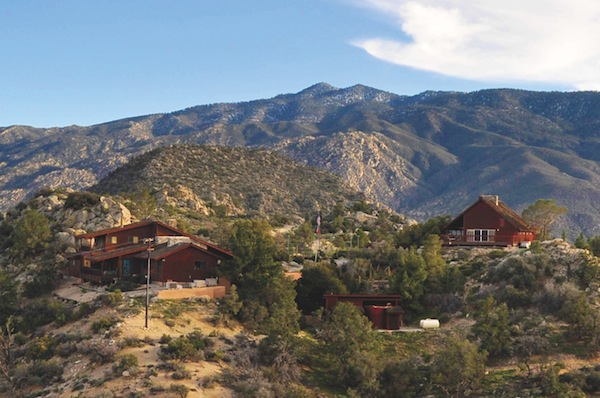
PHOTOGRAPHS BY ANTHONY LAGROSA AND ABRAHAM RIVERA
The Villa was a refuge during the entertainer’s first self-imposed retirement.
Sinatra had named the retreat after the role that won him the Academy Award back in 1954, the featherweight soldier who ends up a hero before Pearl Harbor — a role he had fought so hard for, and that Ava had grabbed credit for his getting.
No need to look too hard for orange at Maggio, incidentally — it was everywhere, starting with the stone on the main chalet. Frank had made sure the stone was turned to the side so that the orange patina on the rock was visible. Meanwhile in the kitchen, the tiles around the counter were orange and the color was sprinkled throughout the buildings. Against all that mountain greenery, it stood out even more.
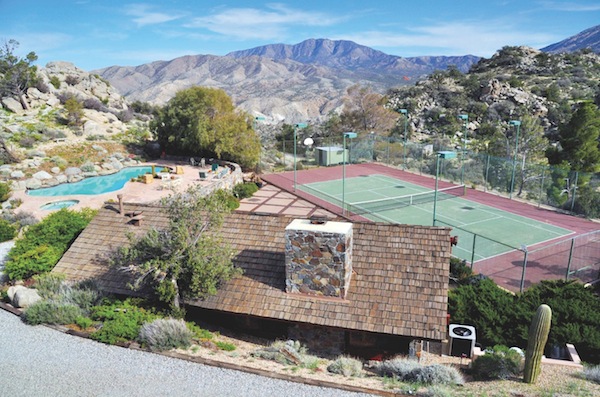
PHOTOGRAPHS BY ANTHONY LAGROSA AND ABRAHAM RIVERA
The property comprised a lighted swimming pool and spa, a tennis and basketball court, and the convenient lighted helipad.
Frank’s “retirement” lasted two years. In 1973, he released the LP Ol’ Blue Eyes Is Back, and thereafter the renaissance of his career was in full swing. In 1980, twelve years into owning the Villa Maggio property, Sinatra donated the whole shebang to Loyola Marymount College, who sold it nine years later for a cool $1.4 million. In May of this year, it was back on the market for $3.9 million.
DESERT MEMORIAL PARK (1998-Eternity)
69920 Ramon Road, Cathedral City
In the first months of 1998, Sinatra was rushed to a hospital in Los Angeles twice. At a Mother’s Day poker game, friends recalled that he was even thinner than usual and weak looking. He told Tom Dreesen he loved him. He laughed when Jerry Vale told a joke. But he felt the end was near; he faced “the final curtain” he had sung about so sweetly.
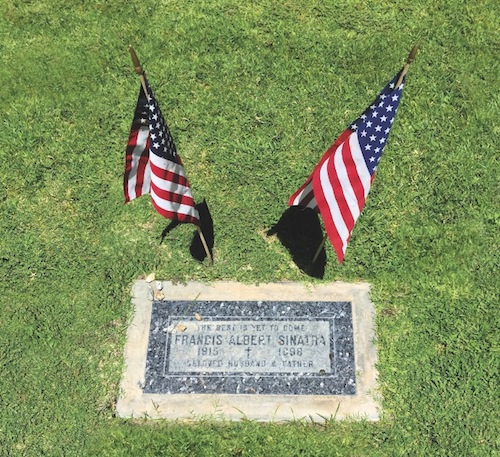
PHOTOGRAPH BY STUART FUNK
Frank Sinatra wanted a simple headstone.
He died in the emergency room of Cedars-Sinai Medical Center, Barbara holding him. She kept encouraging him to “fight!” but it was to no avail. His last words were, “Oh dear Lord, oh mother.” A close friend who was there when he died told a Philadelphia paper that “when the end finally came, Frank sighed so deeply it seemed the world’s woes had blown out of his body.”
Unlike a lot of Hollywood celebrities, Sinatra wanted only a simple headstone. He is buried next to his mother, Natalie Catherine Garavente of Genoa, Italy, and his father, Anthony Sinatra. Frank’s coffin at space B-8-151 is said to be lined with lead to foil grave robbers.